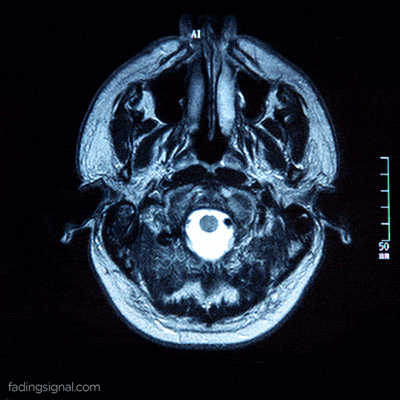A wearable headset allowing users to communicate with technology without even speaking a word could revolutionize future communication. Arnav Kapur created a device called AlterEgo, a wearable headset designed to change the way we interact with technology. This device records signals when a user hears or thinks of something and this information, in turn, is sent to the machines which use the internet to find answers to what the user is thinking of, reported CNBC. Wearing the device is like having Google in your head, with access to anything on the internet. The highlight of the feature is that the user doesn't need to speak, type, or make any tangible effort for the device to work. You just have to think of something and the device will search the internet for you and then it will feed the answer back into your brain via skull vibrations through your inner ear.
Arnav said the answer presents itself in a voice similar to the person's inner voice and that too without interfering with their usual auditory perception. The device can search for information, solve math equations and answer all kinds of questions that arise in your mind. MIT Media lab explained that this enables human-computer interaction that is subjectively done internally and is like speaking to yourself. "This enables a user to transmit and receive streams of information to and from a computing device or any other person without any observable action, in discretion, without unplugging the user from her environment, without invading the user's privacy," the organization adds. In a video demonstrating the device, Arnav is asked a super difficult maths question that he is able to solve in next to no time with the help of the device.
To showcase other uses of the device, he is asked to name the capital of Bulgaria and the population of the region as well, which he answers without any problem as well. The inventor shared that the idea behind his device is to have the entire internet within your head. Another focus of the device is also to help those who have been diagnosed with speech disorders and make communication easier for people with neurological disorders. The primary focus of the device is to support communication for people who have been diagnosed with conditions like ALS (amyotrophic lateral sclerosis) and MS (multiple sclerosis) as per MIT.
"Beyond that, the system has the potential to seamlessly integrate humans and computers - such that computing, the Internet, and AI would weave into our daily life as a 'second self' and augment our cognition and abilities," the institution adds The new device is truly brilliant and is bound to help people by a great measure. The device also shows how far we've come from a technological standpoint and how computers are gradually becoming a part of us. But this also gives rise to the question, if our thoughts can access the internet, will it be possible for the internet to access the brain? Until then, we can appreciate the device that will make life easier for millions of people.
As of now, AlterEgo has been able to solve arithmetic problems, play chess and even control a Roku streaming user interface. It was found that AlterEgo had an average transcription accuracy of 92% from a 10-person trial, reported CNBC. There are possibilities of the device being able to act as an aid for people with speech impairments and in military operations.
This article originally appeared on 02.26.24

















 Blue Ghost Mission 1 - Sunset Panorama GlowPhoto credit:
Blue Ghost Mission 1 - Sunset Panorama GlowPhoto credit: 
 medical school brain GIF
medical school brain GIF woman leaning on man's shoulder
Photo by
woman leaning on man's shoulder
Photo by 
 Ripe bananas
Ripe bananas How we treat produce could be changing for the better.
How we treat produce could be changing for the better.
 The hole in the ozone layer in 2015.Photo credit: Wikimedia Commons
The hole in the ozone layer in 2015.Photo credit: Wikimedia Commons In the 1980s, CFCs found in products like aerosol spray cans were found to cause harm to our ozone layer.Photo credit: Canva
In the 1980s, CFCs found in products like aerosol spray cans were found to cause harm to our ozone layer.Photo credit: Canva Group photo taken at the 30th Anniversary of the Montreal Protocol. From left to right: Paul Newman (NASA), Susan Solomon (MIT), Michael Kurylo (NASA), Richard Stolarski (John Hopkins University), Sophie Godin (CNRS/LATMOS), Guy Brasseur (MPI-M and NCAR), and Irina Petropavlovskikh (NOAA)Photo credit: Wikimedia Commons
Group photo taken at the 30th Anniversary of the Montreal Protocol. From left to right: Paul Newman (NASA), Susan Solomon (MIT), Michael Kurylo (NASA), Richard Stolarski (John Hopkins University), Sophie Godin (CNRS/LATMOS), Guy Brasseur (MPI-M and NCAR), and Irina Petropavlovskikh (NOAA)Photo credit: Wikimedia Commons
 Getting older means you're more comfortable being you.Photo credit: Canva
Getting older means you're more comfortable being you.Photo credit: Canva Older folks offer plenty to young professionals.Photo credit: Canva
Older folks offer plenty to young professionals.Photo credit: Canva Eff it, be happy.Photo credit: Canva
Eff it, be happy.Photo credit: Canva Got migraines? You might age out of them.Photo credit: Canva
Got migraines? You might age out of them.Photo credit: Canva Old age doesn't mean intimacy dies.Photo credit: Canva
Old age doesn't mean intimacy dies.Photo credit: Canva
 University President Eric Berton hopes to encourage additional climate research.Photo credit: LinkedIn
University President Eric Berton hopes to encourage additional climate research.Photo credit: LinkedIn